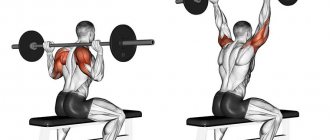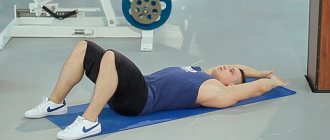7621
November 12, 2016
Fitball for babies. How to choose. Exercises for children from birth, at 1-1.5 months, 3-4 months, 5-6 months, after 6 months. Lots of video instructions.
It is no secret that the physical development of a child up to one year is one of the main indicators of his health. There are many ways to help your child learn new skills. In this article we will talk about exercises on a fitball - a special gymnastic ball that is useful not only for doing exercises with a child, but also for maintaining good physical shape of all family members.
The benefits of fitball
Gymnastics on a fitball for infants is necessary and useful for the following reasons:
- Increased muscle tone is eliminated.
- Abs and posture are formed.
- Muscles are being trained.
- Bones are strengthened.
- The vestibular apparatus and coordination develop.
- The functioning of internal organs and intestines is normalized (with the help of exercises on a fitball, mothers will get rid of sleepless nights due to infant gas and colic).
- The pressure stabilizes.
- The baby relaxes and receives a lot of positive emotions.
- The body receives a massage.
Fitball is useful for entertainment and health promotion. It is a mistake to believe that such gymnastics is needed only for those children who have neurological and physiological defects. Warm-up and communication with mother will not interfere with absolutely healthy babies.
Interesting! Fitball was invented in Switzerland. The author of the method is doctor S. Kleinvogelbach. Initially, ball gymnastics was used to treat patients with spinal injuries. The simulator was named the Swiss ball after its birthplace.
The problem of losing weight after childbirth
After childbirth, it can be difficult to return to normal your previous shape. That's why you need to know why changes occur in the body.
Reasons why excess weight is gained:
- there is no control over a balanced diet (we justify to ourselves that the baby needs it);
- restriction in movement: this leads to the fact that accumulated energy is not spent properly;
- during pregnancy, a protective mechanism is activated and a fat layer is formed and actively develops on the waist, hips, and abdomen;
- genetic inheritance;
- accumulation of excess fluid in the body.
Which ball is better to choose
When buying a fitball for exercising with a baby, parents need to pay attention to the following parameters:
- Ball size.
The optimal diameter of a gymnastic apparatus for newborns does not exceed 45 cm. For children under one year old, an apparatus with a circumference of 75 cm is suitable for adults. - Elasticity. The surface should be springy and hard. Check this parameter in the store by pinching the projectile. If the rubber quickly returned to its original position, then the product is of high quality and is suitable for training with infants.
- Material. Fitballs are made from rubber, caoutchouc, and latex. For infants, choose an odorless ball; the material does not really matter.
- Surface. The smooth version is suitable for babies. Children after one year - with thorns, horns, pimples. Also pay attention to the seams and valve. Protruding elements can injure a newborn, so the inflation valve should be hidden inside, and the seams should be barely noticeable.
- Anti-explosion system. If the projectile is marked ABS, then it will withstand a weight of up to 300 kg, will not explode under the load, but may deflate if it is exceeded.
- Color. For infants, choose exercise equipment in pastel colors. Poisonous greens, garish oranges and reds are most often cheap knockoffs.
- Manufacturer. Choose Italian, German, American balls. They will last more than 10 years.
- Equipment. A good set must include an inflator.
Important! Buy a fitball at a sports or children's store. The likelihood of purchasing a quality product in branded retail chains is much higher.
Result
Exercises performed with a fitball after childbirth promote rapid regeneration of the body. Specially selected exercises will help improve your mood, tone up and prepare your body for work. Such exercises involve all muscles, posture improves, back muscles are strengthened (without overloading it), joints become mobile.
The cushioning of the ball relaxes the spinal column, strengthens the cardiovascular and nervous system, improves blood circulation and metabolism. But another benefit is that it lifts your mood throughout the day.
Fitball is a projectile that requires coherence in the work of the vestibular, motor, tactile and visual apparatus. Therefore, you need to know how to choose it correctly.
How to recognize a fake
With the growing popularity of fitball training, sports equipment began to be counterfeited more often.
It is very easy to recognize a low-quality product using the following criteria:
- Low price. A good ball of small diameter, suitable for infants, will cost more than 800-1000 rubles.
- Protruding seams, inflation valve. Feel the projectile with your palm. If you feel roughness, burrs on the surface, seams protruding clearly, then the ball is fake.
- Folds. Even a well-inflated ball does not have a smooth surface, which means the rubber is thin. It stretches and has a low density. Such a simulator will become unusable in a couple of days.
- Strong unpleasant odor. The material has an unnatural, chemical smell. Inhaling this “aroma”, the baby can be poisoned.
- Bright colors and drawings. High-quality branded balls are made in a single-color version.
- Erased inscriptions. For professional manufacturers, the label does not wear off for years.
At what age to start
You can start exercising your child on a fitball at any age. The earliest is considered to be 3 weeks after birth.
By this time, the umbilical wound has healed, the mother recognizes the baby’s temperament and can confidently hold him. Parents will feel the benefits of swinging on a large ball almost immediately. The baby will calm down and have fun.
Interesting! Dr. Komarovsky speaks out against rocking of newborn babies. He believes that this procedure only brings harm. But the fitball is treated very positively, if you do not use the gymnastic ball as a saddle for a tired mother who is trying hard to put her child to sleep.
Important Rules
When creating a schedule for activities with your child and choosing a set of exercises, parents should take into account some generally accepted rules:
- Start your first introductory lessons with your baby no earlier than 2-3 weeks after birth.
- The introductory lesson lasts no more than 5 minutes. The baby needs to get used to the ball and new tactile sensations.
- Increase the duration of the exercises gradually, focusing on the baby’s well-being, his interest, and mood. By 2-3 months, exercise on the ball lasts 8-10 minutes.
- Wash the ball and your hands thoroughly before class.
- There is no need to pump the projectile as much as possible. It should spring back a little.
- Place a flannel diaper on the gymnastic ball. This is necessary so that the baby does not slip off.
- Turn on soft, calm music.
- Take the child, hold him on the ball confidently, firmly. For newborn babies, secure the cervical spine well.
- Regardless of the baby's age, ankles and wrists are not suitable for holding them on the ball. The joints are not strong enough - dislocations and injuries are very easy to get. It is better for adults to hold the child by the torso: forearm, chest, tummy, back.
- It is strictly forbidden to leave a baby unattended. A child will be able to exercise independently, swing and jump on a fitball only after 1-2 years.
- Conduct active activities in the morning, calm ones in the evening, so that the little child does not become overexcited and falls asleep well.
- You cannot do gymnastics immediately after eating. Wait 1 - 1.5 hours after feeding or start exercising 30 minutes before eating.
- To get the most positive effect from exercise, it is better to undress the child. The body will be in contact with the ball over its entire surface, the receptors and muscles will receive a good load.
- Plan lessons only on those days when the baby is healthy, cheerful, and good at interacting. If your child is not in the mood and cries on the ball, take a break.
- Choose a set of exercises on a fitball, taking into account the age of the baby.
- During gymnastics, sing, talk to your child, read poems and jokes.
Important! You need to wipe the fitball before each lesson. Babies, lying on their tummy, will definitely try to taste it.
Features of exercise therapy with fitball
Before starting classes, you should choose a suitable ball to avoid problems when performing exercises on the apparatus. An incorrectly selected fitball can cause injury; exercise with it is not only ineffective, but harmful.
There are 5 types of balls available:
- 45 cm – with a height of up to 1.5 meters;
- 55 cm – height from 1.5 to 1.65 meters;
- 65 cm – up to 1.85 meters;
- 75 cm – up to 2 meters;
- 85 cm – from 2 meters and above.
You can check how well the ball fits by sitting down on it with your feet straight in front of you. Ideally, the knees form a right angle relative to the floor. If they ride up higher, the fitball is too small; if you can’t put your feet on the floor without effort, it’s too big.
Pre-warm-up is a prerequisite when performing exercises on the ball. As with ordinary physical education, you only need to start the exercise by thoroughly warming up all muscle groups, for example, by running in place, jumping, or fast dancing.
Another important rule: strict adherence to proper breathing during exercise.
Exercises
Training complexes for fitball are usually divided into several groups according to the age of the infants. Parents should understand that these tasks are classified as general strengthening tasks and are intended for children without developmental pathologies.
To solve health problems with the help of a fitball, we recommend that you consult a doctor. The doctor will prescribe a special course of gymnastics, which will be more effective and targeted.
Exercises for children up to 3 months
Newborn babies love to swing on a fitball. The basic gymnastic exercises for babies of this age are based on this principle. The baby is laid on his tummy, the mother sits on the floor or stands nearby so that the hold is strong. Complete the following tasks, devoting 1-2 minutes to each.
Swing
The exercise is performed on the stomach and back alternately. In the stomach position, hold the baby with your hand, placing it in the area of the shoulder blades, and clasp the legs with the other palm. Make swaying movements left and right, back and forth. In a supine position, it is better to clasp the ball with your legs so that the fixation is stronger.
Spring
A two-month-old baby lies on a fitball with his belly. Hold the baby's legs and lightly press on the butt so that the ball bounces up and down.
Rotations
Spin the fitball clockwise. Hand movements should be done slowly, remembering to hold the baby tightly.
Leg kicks
Mom’s pet or darling lies on the sofa, a fitball is rolled up to his heels. The baby rests his feet on the ball, the surface is springy.
Watch the video on how to perform these exercises:
Classes for children from 3 to 6 months
Gymnastics with a fitball is much easier to do at the age of three months. The baby holds his head, his neck is stronger, he rests his hands on the surface, tries to roll over and sit down. Help him learn new tasks and his physical skills will develop faster.
Wheelbarrow
The baby lies face down, resting his hands on the projectile. Mom swings the fitball forward, taking a couple of steps, then back. The child is forced to move his palms to maintain position.
Reach for the toy
The baby is placed on the belly and held well by the legs. Tilt the fitball forward so that the baby can reach the floor with his palms. Place several bright toys near the ball, the baby will try to get them.
Jumper
The most favorite exercise for infants. Place the baby on the ball and hold it under your arms. Hold the fitball with your feet. Help your child jump, make sure he bends his knees and pushes off on his own.
Little Frog
The child lies on his stomach. The mother swings the ball back and forth, bending and unbending the baby’s legs at the knees.
Airplane
Lay the baby on his stomach and rock him on the ball a couple of times. Gently secure the baby's forearm and lower leg and turn him onto his side. Rock on one side, then switch to the opposite position.
Important! The set of tasks does not change with age, but is supplemented. Don't stop doing simple exercises for newborns, use them as a warm-up, and new ones as the main part.
Watch the exercise video below:
Exercises for children 6 months and older
In six months, it is important to strengthen the muscles of the legs, back, and spine. Exercises on a fitball are aimed at learning to sit, stand, walk, and train the vestibular system.
Downloading the press
The baby is placed on the back. The ball is firmly fixed with the feet of an adult. The mother pulls the baby by the arms, holding the forearms, sits the baby up, then carefully lowers him to the starting position.
Learning to stand
The fitball acts as a support for the baby. The mother places the child near the ball and rests the child’s palms on it. Hold the projectile so that it does not roll away. Slowly release the child and let him stand on his own. 2-3 seconds is enough.
Drag
Requires two adults to complete. One holds the child by the legs, the other by the hands. The baby lies face down. Parents carefully pull the baby towards them one at a time.
horse
The baby must be able to sit. The mother puts the child on the exercise machine astride and helps him bounce on his butt. You can press the ball so that it springs along with a small load.
Keeping your balance
Place the baby on the fitball and find a fulcrum.
Place your hands on your child's lap. Let him sit for 3-5 seconds almost independently, keeping his body in one position.
Help for parents! Download pictures online describing exercises on a fitball for infants. Print the instructions and keep them handy during class. This way you won’t forget or confuse anything.
A set of exercises for dysplasia
Dysplasia is common in infants. This violation of the formation of joint tissues is detected during the neonatal period. You can correct the situation if you regularly conduct fitball exercises at home, invite a specialist for medical massage and do not forget about the morning warm-up.
The following exercises on a Swiss ball are useful for children with dysplasia:
- Place the baby on his back and support the body with your hand on his tummy. Press the child's pelvis against the ball. Hold your legs in your palms and make circular movements with them clockwise. Repeat 5 times.
- Do not change the child's position on the fitball. Raise one leg and spin the bike 4-5 times, then do the same with the other leg.
- Turn the baby onto his stomach. Let him grab the ball with his hands, hold his body. Bend your legs at the knees and place them in a frog pose. Press your knees to the fitball, fix for 5 seconds, straighten. Repeat 8 times.
- Maintain the position on your stomach. Bend your knees so that the heels of both legs touch and your feet rise towards your butt. Hold for 5 seconds, release. You need to repeat 6-8 times.
Important! Prevention and treatment of dysplasia during the neonatal period will protect the child from lameness and joint defects in the future.
The most effective and popular exercises for infants
- Swinging on the tummy Place the baby's belly in the middle of the fitball and, confidently holding it by the back with your hands, rock it back and forth, then left and right, and then in a circle.
- Rocking on the back Place the child on the ball with his back (we fix the fitball with our feet) and repeat the exercises from the previous point.
- the spring of the Child on the ball with its belly down. We grab his legs using the “fork” principle (with the thumb - a ring around the legs, the ankle - between the index and middle fingers). With your free hand, lightly press on the toddler’s butt or back with springy “up and down” movements—short and soft pushes.
- Watch We place the baby with his back on the fitball. We hold the chest with both hands, rock the baby, making circular movements to the right and left.
Exercises for muscular dystonia
With muscle dystonia, children experience hypotonicity or hypertonicity. For treatment and health promotion, use the pool, massages and fitball exercises at home. The standard set of tasks includes the following exercises:
- Do it together. Place the baby on the ball. One adult holds the straight legs, the other holds the arms. Roll your baby back and forth on the ball. Repeat 10 times.
- Don't change your position. Secure the child's back with your palm, tilt the fitball forward until the baby reaches the floor with his palms. Then take the baby's hands and release the legs. Tilt the ball back until your child's feet touch the floor. Repeat the bends 5 times. Do this exercise with 9 month old – one year old children.
- The baby lies on his back, the mother places her palm on his tummy. The ball rolls in different directions at low speed. This exercise relaxes the back muscles well.
Conclusion
Thus, daily exercise on a fitball is a good way to improve a child’s physical development and strengthen his muscles.
The baby will better coordinate changes in body position, his mood will improve, he will sleep more soundly and eat better. Walking, crawling, sitting, holding the head during such physical activity in the baby begins a little earlier. It is necessary to remember that the baby’s health program includes not only fitball, but also massage, gymnastics, swimming, and hardening. It should be noted that in a child under 1 year of age, intellectual development is equal to physical development. The faster the baby learns to control his body, the faster he will have opportunities to explore the world around him.
It follows from this that it is necessary to play sports as early as possible, since the health of a child is established from a very tender age.











